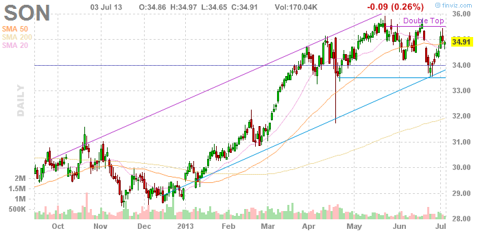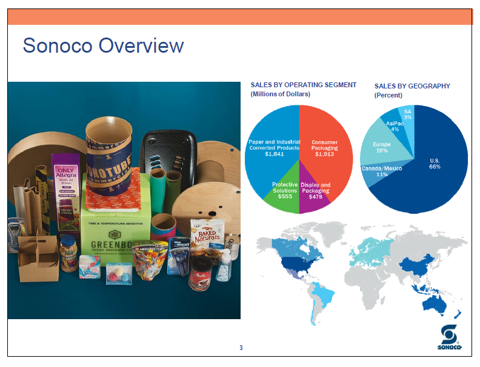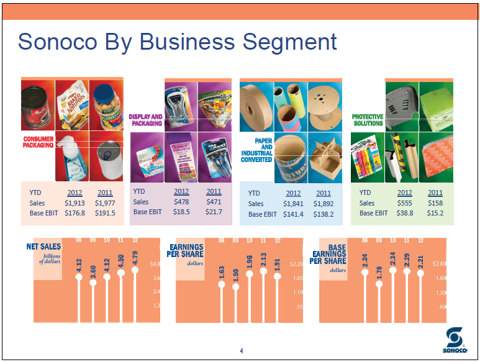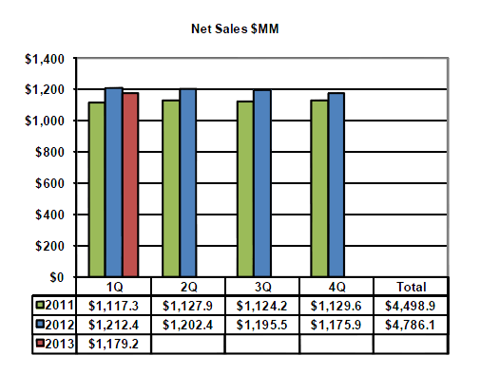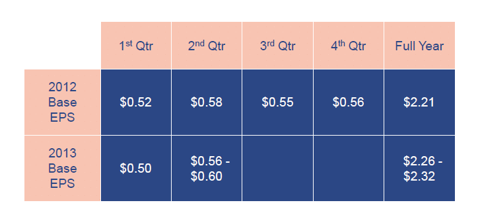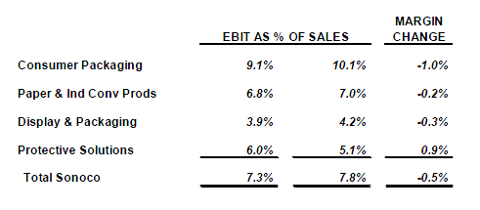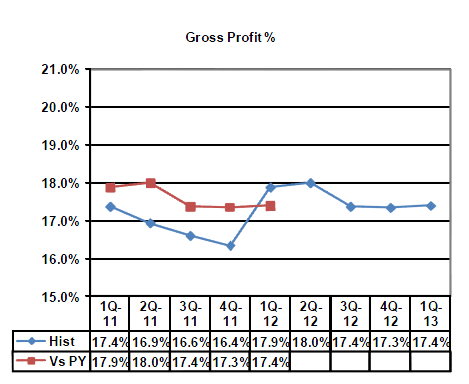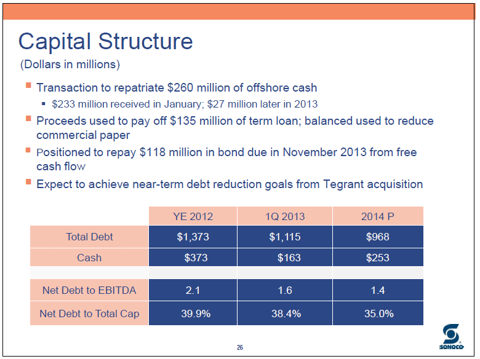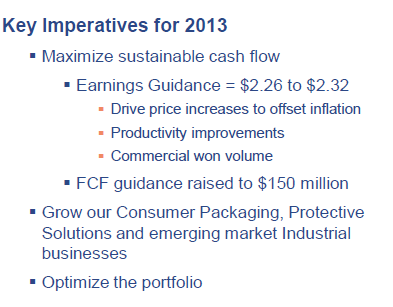I went out on a limb last week, and now it's time to see how that decision played out.
I predicted that Stratasys (NASDAQ: SSYS ) would close higher on the week. The maker of 3-D printers was a hot stock last year before cooling off in 2013, but I figured its quarterly report on Monday could get the bullish sentiment rolling again. It was a well-received report, and Stratasys went on to inch higher in four of the five trading days. The stock rose nearly 6% on the week. I was right. I predicted that the tech-heavy Nasdaq would outperform the Dow Jones Industrial Average. (DJINDICES: ^DJI ) . This has been a tricky call lately, so how did it play out this time? Well, the market had a strong run this week, fueled by encouraging corporate developments. Secondary stocks led the way with Nasdaq soaring 1.8% on the week. The Dow managed to close just 1.6% higher. I was right. My final call was for Applied Materials (NASDAQ: AMAT ) to beat Wall Street's income estimates in its latest quarter. The provider of gear, services, and software to assist in the making of advanced semiconductors, flat-panel displays, and solar photovoltaic products companies has been posting blowout quarterly results over the past year, and I was banking on seeing the trend continue. Analysts were looking for a profit of $0.13 a share during the quarter, and Applied Materials came through with earnings of $0.16 a share. I was right.
Three out of three? Awesome! That makes me 11 of 12 over the past four weeks.
Top 5 Semiconductor Stocks To Own Right Now: Xilinx Inc (XLNX)
Xilinx, Inc. (Xilinx), incorporated on February 5, 1984, designs, develops and markets programmable platforms. These programmable platforms have a number of components, including integrated circuits (ICs) in the form of programmable logic devices (PLDs), including Extensible Processing Platforms (EPPs); software design tools to program the PLDs; targeted reference designs; printed circuit boards, and intellectual property (IP), which consists of Xilinx and various third-party verification and IP cores. In addition to its programmable platforms, Xilinx provides design services, customer training, field engineering and technical support. The Company�� PLDs include field programmable gate arrays (FPGAs), complex programmable logic devices (CPLDs) that its customers program to perform logic functions, and EPPs. Xilinx�� products are offered to electronic equipment manufacturers in end markets, such as wired and wireless communications, industrial, scientific and medical, aerospace and defense, audio, video and broadcast, consumer, automotive and data processing. The Company sells its products globally through independent domestic and foreign distributors and through direct sales to original equipment manufacturers (OEMs) by a network of independent sales representative firms and by a direct sales management organization. In January 2011, the Company acquired AutoESL Design Technologies, Inc. In August 2012, the Company acquired embedded Linux solutions provider PetaLogix.
Product Families
The 7 series devices that comprise the Company�� 28-nanometer (nm) product families are fabricated on a high-K metal gate 28-nm process technology. These devices are based on an architecture, which enables design and IP portability and re-use across all families, as well as provides designers the ability to achieve the appropriate combination of I/O support, performance, feature quantities, packaging and power consumption to address a range of applications. The 7 series devices consist of! three families: Virtex-7 FPGA, Kintex-7 FPGAs and Artix-7 FPGAs. The Zynq-7000 family is the family of Xilinx EPPs. The Virtex-6 FPGA family consists of 13 devices and is the sixth generation in the Virtex series of FPGAs.
Virtex-6 FPGAs are fabricated on a high-performance, 40-nm process technology. There are three Virtex-6 families: Virtex-6 LXT FPGAs, Virtex-6 SXT FPGAs and Virtex-6 HXT FPGAs. The Spartan-6 family is the PLD industry�� 45-nm high-volume FPGA family, consisting of 11 devices in two product families: Spartan-6 LX FPGAs and Spartan-6 LXT FPGAs. The Virtex-5 FPGA family consists of 26 devices in five product families: Virtex-5 LX FPGAs for logic-intensive designs, Virtex-5 LXT FPGAs for high-performance logic with serial connectivity, Virtex-5 SXT FPGAs for high-performance DSP with serial connectivity, Virtex-5 FXT FPGAs for embedded processing with serial connectivity and Virtex-5 TXT FPGAs for high-bandwidth serial connectivity. Prior generation Virtex families include Virtex-4, Virtex-II Pro, Virtex-II, Virtex-E and the original Virtex family. Spartan family FPGAs include 90-nm Spartan-3 FPGAs, the Spartan-3E family and the Spartan-3A family. Prior generation Spartan families include Spartan-IIE, Spartan-II, Spartan XL and the original Spartan family.
Design Platforms and Services
The Company offers three types of programmable platforms. The Base Platform is the delivery vehicle for all of its new silicon offerings used to develop and run customer-specific software applications and hardware designs. The Base Platform consists of FPGA silicon; Integrated Software Environment (ISE) Design Suite design environment; integration support of optional third-party synthesis, simulation, and signal integrity tools; reference designs; development boards and IP. The Domain-Specific Platform targets one of the three primary Xilinx FPGA user profiles: the embedded processing developer; the DSP developer; or the logic/connectivity developer. The Market-S! pecific P! latform enables software or hardware developers to build and run their specific application or solution. Built for specific markets, such as automotive, consumer, aerospace and defense, communications, audio, video and broadcast, industrial, or scientific and medical, the Market-Specific Platform integrates both the Base and Domain-Specific Platforms.
During April 2012, Xilinx introduced the Vivado Design Suite. Vivado supports Xilinx 7 series FPGAs and Zynq EPPs. Xilinx and various third parties offer hundreds of no charge and fee-bearing IP core licenses covering Ethernet, memory controllers Interlaken and PCIe interface, as well as domain-specific IP in the areas of embedded, DSP and connectivity, and market-specific IP cores. The Company also offers development kits, including hardware, design tools, IP and reference designs. Xilinx offers a range of configuration products, including one-time programmable and in-system programmable storage devices to configure Xilinx FPGAs. These programmable read-only memory (PROM) products support all of the Company�� FPGA devices. Xilinx and certain third parties have developed and offer a ecosystem of IP, boards, tools, services and support through the Xilinx alliance program. Xilinx also works with these third parties to promote its programmable platforms through third-party tools, IP, software, boards and design services. Xilinx engineering services provide customers with engineering, ranging from hands-on training to full design creation and implementation.
The Company competes with Altera Corporation, Lattice Semiconductor Corporation and Microsemi Corporation.
Top 5 Semiconductor Stocks To Own Right Now: Analog Devices Inc (ADI.O)
Analog Devices, Inc. (Analog Devices), incorporated on January 18, 1965, is engaged in the design, manufacture and marketing of a range of analog, mixed-signal and digital signal processing integrated circuits (ICs). The Company produces a range of products, including data converters, amplifiers and linear products, radio frequency (RF) ICs, power management products, sensors based on micro-electro mechanical systems (MEMS) technology and other sensors, and processing products, including DSP and other processors, which are designed to meet the needs of a base of customers. The Company's products are embedded inside many different types of electronic equipment, including industrial process control systems; instrumentation and measurement systems; wireless infrastructure equipment, and aerospace and defense electronics. The Company designs , manufactures and markets a range of ICs, which incorporate analog, mixed-signal and digital signal processing technologies. The Comp any's product portfolio includes both general-purpose products used by a range of customers and applications, as well as application-specific products. On March 30, 2012, the Company acquired Multigig, Inc.
Analog Products
The Company's product portfolio includes several thousand analog ICs. The Company's analog IC customers include original equipment manufacturers (OEMs) and customers who build electronic subsystems for integration into larger systems. The Company is a supplier of data converter products. Data converters translate real-world analog signals into digital data and also translate digital data into analog signals. The Company is also a supplier of amplifiers. Amplifiers are used to condition analog signals. The Company provides precision, instrumentation, intermediate frequency/radio frequency (RF), broadband, and other amplifiers. The Company also offers a range of precision voltage references, which are used in a range of application s. The Company's analog product line also includes a range! p! ortfolio of RF ICs covering the RF signal chain, from RF function blocks, such as phase locked loops, frequency synthesizers, mixers, modulators, demodulators, and power detectors, to broadband and short-range single chip transceiver solutions.
The Company's RF ICs support the requirements of cellular infrastructure and a range of applications in the Company's target markets. Also within the Company's analog technology portfolio are products, which are based on MEMS technology. This technology enables the Company to build small sensors, which incorporate an electromechanical structure and the supporting analog circuitry for conditioning signals obtained from the sensing element. The Company's MEMS product portfolio includes accelerometers used to sense acceleration, gyroscopes used to sense rotation, inertial measurement units used to sense multiple degrees of freedom combining multiple sensing types along multiple axis, and MEMS microphones used to sense audio . The Company's current revenue from MEMS products is derived from the automotive end market. In addition to the Company's MEMS products, its other analog product category includes isolators. The Company's isolators have been designed for applications, such as universal serial bus isolation in patient monitors, where it allows hospitals and physicians to adopt the advances in computer technology to supervise patient health and wirelessly transmit medical records. In smart metering applications, the Company's isolators provide electrostatic discharge performance. In satellites, where any malfunction can be catastrophic, the Company's isolators help protect the power system while enabling designers to achieve small form factors. Power management & reference products make up the balance of the Company's analog sales. Those products, which include functions such as power conversion, driver monitoring, sequencing and energy management, are developed to complement analog signal ch ain components across core market segments from micro ! power,! e! nergy-s! ensitive battery applications to power systems in infrastructure and industrial applications.
Digital Signal Processing Products
Digital Signal Processing products (DSPs) complete the Company's product portfolio. DSPs are optimized for numeric calculations, which are essential for instantaneous, or real-time, processing of digital data generated, from analog to digital signal conversion. The Company's DSPs are designed to be fully programmable and to execute specialized software programs, or algorithms, associated with processing digitized real-time, real-world data. Programmable DSPs are designed to provide the flexibility to modify the device's function using software. The Company's DSP IC customers write their own algorithms using software development tools provided by the Company and third-party suppliers. The Company's DSPs are designed in families of products, which share common architectures and therefore can execute the same software across a range of products. The Company's customers use the Company's products to solve a range of signal processing challenges across its core market and segment focus areas within the industrial, automotive, consumer and communications end markets. As an integrated part of the Company's customers' signal chain, there are other Analog Devices products connected to its processors, including converters, audio and video codecs and power management solutions.
The Company competes with Broadcom Corporation, Maxim Integrated Products, Inc., Cirrus Logic, Inc., Microchip Technology, Inc., Freescale Semiconductor, Inc., NXP Semiconductors, Infineon Technologies, ST Microelectronics, Intersil Corporation, Silicon Laboratories, Inc., Knowles Electronics, Texas Instruments, Inc. and Linear Technology Corporation.
5 Best Canadian Stocks To Invest In Right Now: NVIDIA Corp (NVDA.F)
NVIDIA Corporation (NVIDIA), incorporated on February 24, 1998, is engaged in creating the graphics chips used in personal computers (PCs). The Company operates in three segments: graphics processing unit (GPU) Business, professional solutions business (PSB) and consumer products business (CPB). Its mobile processors are used in cell phones, tablets and auto infotainment systems. Designers use GPUs to create visual effects in movies and create everything from golf clubs to jumbo jets. NVIDIA solutions are based on two technologies: the GPU and the mobile processor. GPUs are the engines of visual computing, the science and art of using computers to understand, create and enhance images. It has three GPU product brands: GeForce, which creates visual experiences for gamers; Quadro, which is engaged in visual computing for designers and digital artists, and Tesla, which accelerates applications for scientists and researchers. Tegra is its mobile processor and is built for a pplications ranging from smartphones, tablets and notebook PCs to televisions and cars. During the fiscal year ended January 29, 2012 (fiscal 2012), it acquired Icera Inc.In fiscal 2012, it launched Project Maximus, which uses the compute power of Tesla with the visualization power of Quadro to merge the design and simulation stages into one workstation. In May 2012, the Company and Intellectual Ventures announced that they jointly acquired a set of patents developed and owned by IPWireless. The portfolio comprises approximately 500 patents granted and pending in the wireless communications area, including concepts in LTE, LTE-Advanced and 3G/4G technologies.
GPU Business
The Company�� GPU business revenue includes primarily sales of its GeForce discrete and chipset products that support desktop and notebook PCs plus license fees from Intel and sales of memory products. It also accelerates video editing and high definition (HD), content creation by consumers. GeForce GPUs power PCs made by or distributed! ! by PC original equipment manufacturers (OEMs), in the world. Its media and communications processor (MCP) chipsets primarily comprised of its ION motherboard GPUs, a product reaching the end of its life cycle.
Professional Solutions Business
The Company�� PSB consists of its Quadro professional workstation products and its Tesla computing products. Its Quadro products are designed to deliver the graphics performance and application compatibility for professionals. Tesla applies the processing power of its GPUs to general-purpose computing problems. Quadro products add functionality, such as photorealistic rendering, to computer-aided design workstations, and are used in professional video editing applications and for generating special effects in movies. Tesla is used in supercomputing centers and in oil exploration; other applications include accelerating drug discovery, weather simulations and derivative price modeling.
Consumer P roducts Business
The Company�� CPB includes its Tegra system-on-chip products for smartphones, tablets, automotive infotainment systems, and other similar devices, and Icera baseband processors. The Tegra revenues are generated by sales in smart phones and tablets. CPB also includes license, royalty, other revenue and associated costs related to video game consoles and other digital consumer electronics devices. NVIDIA Tegra mobile products implement design techniques, both inside the chips and at the system level. These technologies enhance visual display capabilities, connectivity and minimize chip and system-level power consumption. During fiscal 2012, it launched Tegra 3, quad-core mobile computing chip, bringing PC levels of performance within the power envelope of a cellular phone chip. It also launched DirectTouch.
The Company competes with Advanced Micro Devices (AMD), Intel, Matrox Electronics Systems Ltd., VIA Technologies, Inc., ARM Hol dings plc, Broadcom Corporation, Freescale Semiconducto! r Inc! .,! Fujits! u Limited, Imagination Technologies Ltd., Intel, Marvell Technology Group Ltd., NEC Corporation, Qualcomm Incorporated, Renesas Technology Corp., Samsung Electronics Co. Ltd., Seiko Epson Corporation, ST-Ericsson, Texas Instruments Incorporated, Toshiba America Electronic Components, Inc., Imagination Technologies Group plc., HiSilicon Technologies Co., Ltd., Mediatek, Qualcomm Incorporated, Spreadtrum Communications Co., Ltd and ST-Ericsson.
Top 5 Semiconductor Stocks To Own Right Now: Texas Instruments Incorporated(TXN)
Texas Instruments Incorporated engages in the design and sale of semiconductors to electronics designers and manufacturers worldwide. The company?s Analog segment offers high-performance analog products comprising standard analog semiconductors, such as amplifiers, data converters, and interface semiconductors; high-volume analog and logic products; and power management semiconductors and line-powered systems. Its Embedded Processing segment includes DSPs that perform mathematical computations to process and enhance digital data; and microcontrollers, which are designed to control a set of specific tasks for electronic equipment. The company?s Wireless segment designs, manufactures, and sells application processors and connectivity products. Its Other segment offers smaller semiconductor products, which include DLP products that are primarily used in projectors to create high-definition images; and application-specific integrated circuits. This segment also provides handhe ld graphing and scientific calculators, as well as licenses technologies to other electronic companies. The company serves the communications, computing, industrial, consumer electronics, automotive, and education sectors. Texas Instruments Incorporated sells its products through a direct sales force, distributors, and third-party sales representatives. It has collaboration agreements with PLX Technology Inc.; Neonode, Inc.; and Ubiquisys Ltd. The company was founded in 1938 and is headquartered in Dallas, Texas.
Advisors' Opinion: - [By Paul Goodwin]
How do they make their money? TXN makes the PA Duplexer Module and the CDMA PA that goes into every iPhone. With a PEG ratio of 0.2 reveals huge discount compared to peers. This is a cash rich company and one I feel will be a strong performer within the next year.
- [By Fabian]
Texas Instruments investment returned 46.3% during the past year. The amount of investment is $403 Million. Miller reduced his TXN holdings by 25% during the last quarter of 2010. Since then the stock returned 11.1%. David Tepper also bought TXN during the third quarter.
Top 5 Semiconductor Stocks To Own Right Now: Micron Technology Inc.(MU)
Micron Technology, Inc., together with its subsidiaries, engages in the manufacture and marketing of semiconductor devices worldwide. Its products include dynamic random access memory (DRAM) products that provide data storage and retrieval, which include DDR2 and DDR3; and other specialty DRAM memory products, including DDR, SDRAM, DDR and DDR2 mobile low power DRAM, pseudo-static RAM, and reduced latency DRAM. The company also offers NAND flash memory products, which are electrically re-writeable and non-volatile semiconductor devices that retain content when power is turned off. In addition, it provides NOR flash memory products that are electrically re-writeable and non-volatile semiconductor memory devices; phase change memory products; and image sensor products. Micron Technology?s products are used in a range of electronic applications, including personal computers, workstations, network servers, mobile phones, flash memory cards, USB storage devices, digital still c ameras, MP3/4 players, and in automotive applications. It sells its products to original equipment manufacturers and retailers through internal sales force, independent sales representatives, and distributors, as well as through a Web-based customer direct sales channel. The company was founded in 1978 and is headquartered in Boise, Idaho.
Advisors' Opinion: - [By Fitz Gerald]
The company's management has indicated a positive and more-balanced DRAM and NAND flash demand/supply outlook for 2011. The company also indicated a more-resilient near-term business model with low exposure to the weak PC DRAM segment (25 percent of revenues).
Micron also indicated strong demand for NAND flash and price reductions consistent with learning curve cost reductions. With many smartphone and iPad/new Web tablets ramping, Micron management expects the benign pricing environment for NAND flash to continue in 2012.
